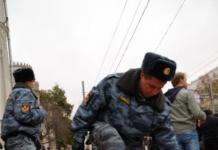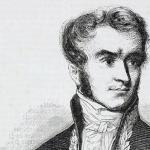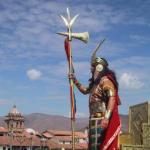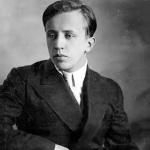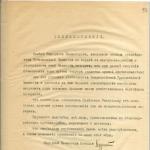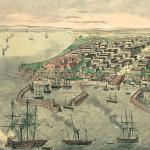The Icon of the Savior, unanimously attributed by researchers to Andrei Rublev, was part of the seven-figure waist row - the Deesis rank, from which images of the Archangel Michael and the Apostle Paul have also been preserved. The original location of the monument is associated with Zvenigorod, where in 1918, under a pile of firewood in a barn, these three icons were discovered.
The Deesis rite is a series of images of saints standing in prayer before Christ placed in the center. Its semantic content is connected with the theme of the Last Judgment: the saints - the Mother of God, John the Baptist, archangels and apostles - ask Christ the Savior (Savior) for mercy on the human race.
The image of the Savior on the Zvenigorod icon has been preserved in fragments, but the features of its construction can be clearly seen. The figure is shown turning to the left of the viewer, the face is strictly in front, the pupils of the eyes are shifted slightly to the right. By combining different points of view, the organic and multi-valued internal movement inherent in Rublev’s images was achieved. The rhythm of this movement connected the Savior both with the half-figures of saints facing him on both sides, and with the upcoming spectators.
All night a blizzard swirled and howled outside the monastery walls, and by morning it got so cold in the cells that the candle wax became amber-transparent, fell off in pieces, and fell with a thud onto the icy floor. The abbot ordered to immediately light all the stoves, and two novices went to the woodshed with orders to bring more aspen - it burns quickly, quickly and cheerfully...
The woodpile of aspen firewood was stacked separately, in the corner of the barn, on thick, half-palm-length boards; the gates were not closed for the sake of light; The novices threw logs into wide sledges; the frozen firewood rang when they hit each other, and the novices threw them in a heap on the sledge, slightly fooling around, and it was warmer that way. They threw it over, grabbed the shafts in order to drag the sledge, and one of the novices tripped over the board on which a woodpile had just been piled up, tripped, almost fell on it with his whole body, fell with his hands, leaned on it, and when he took one hand away from the board, something seemed to him there on her, and he rubbed this “something” with the hem of his cassock and saw a ghost looking at him.
“Wow!” the novice exclaimed and called on his comrade: “look at the board.” And they lifted the board - and it was heavy! - they dragged them to the gate into the light, put it on the end and rubbed their sleeves around the pupil... and someone’s face looked at them, looked sharply and inquisitively; and they, forgetting about the firewood, carried the board to the brethren, the abbot...
Perhaps this is how the Savior “Zvenigorod” by Andrei Rublev, which has been the pride of the Tretyakov Art Gallery for half a century, was saved.
In the current year 2000, inordinately great for its ordinal roundness, supported both from below and from above by national anniversaries (“from below” - 200 years since Pushkin was born, “from above” - 160 years since Lermontov died in a duel), another anniversary should appear, suggesting contains a strange internal asymmetry - 570 years ago the brilliant creator of ancient Russian icon painting Andrei Rublev died and 640 years ago (presumably) was born; and the first date is aimed at the end of winter... 2000.
The axis of this asymmetry took place from the fourteenth century to the fifteenth; the Russian land was just beginning to feel the historical perspective: liberation and national construction - the historical spring coming after the cold winter of the Horde yoke; Rublev - spring artist...
He boldly introduced blue - green - pink - lilac-violet - golden-lemon - silver-fawn - into the ocher-hot color of Byzantine icon-painting asceticism; he gave composition, drawing, and line cosmic fluidity, sophistication and purity, and all this made it possible to distinguish Rublev’s masterpieces from the nameless register of ancient Russian figurativeness; The Master himself did not mark his works with either a letter or a sign, all of them are immersed in the equally nameless womb of cathedrals and churches, given to the glory of the Savior...
And the master did not leave a mark or a sign about his life; and so deeply did he dissolve his life in his time that neither his contemporaries nor his students could convey anything existential about him, nothing chronicle; and all attempts to complete the biography of the brilliant artist result in a description of his icons and frescoes, cities and temples in which he worked, in the construction of probable versions of his deeds with the alleged participation of certain personalities, preserved for Russian history in more detail and fully (abbot Sergius of Radonezh , Nikon, artists Feofan the Greek and Daniil Cherny, Moscow, Serpukhov, Suzdal and other princes...). This is an amazing, purely Russian phenomenon - to dissolve in one’s actions without any visible sediment in the material, created world.
From this position, despite all its uniqueness, Andrei Tarkovsky’s attempt to build his own version of the life of the Master in the film “Andrei Rublev” is understandable.
Remember: horsemen riding out of the low gates of the monastery, trampled snow under the chipped monastery wall, the frosty breath of a monk forcefully opening the oak door, his gaze over the cross, into the thicket of flying crows, shadows on the primed, not yet written down wall, the word disappearing into silence of the temple, waiting for illumination as mercy from above...
or in the frame there is a dazzling, sunny semi-oval of a window, outside the window monastery horses are grazing in a rare young birch forest, and a blind old man with a guide boy are picking up early strawberries, pink berries with a white barrel in the thick grass under the stumps, scattered like precious beads... on the screen hungry eyes of a genius... eyes of a man...
And on a wooden board, found half a thousand years later in the woodshed of the Savvino-Storozhevsky Monastery, a rescued face with the eyes of a god-man flickers...
Savior was able... was able, that’s why he saved. Whom? monk? wretched madwoman? a boy from a pestilential village? the Master himself?
In that barn the entire Zvenigorod Deesis rite was found and saved: the Savior, “Archangel Michael” and “Apostle Paul”. The entire rank is now the property of the Tretyakov Gallery. The hall where they are located I call the hall of the Savior and the Trinity; and every time, entering it, I experience and compare deep fear and bright peace and, surrendering to the real power of the first, I plunge into the cautious inquiry of this power... and least of all I think about the holy genius of the ancient master: he undoubtedly had a co-author... from Him, if not He Himself, and He disposed of His Face in time, allowing it, time, to destroy everything except the Face, now looking at us from the burnt naked wood.
He helped Rublev, and He retained the power of his gaze, completely unbearable by the human spirit, emanating from the Face. The simplest, easiest thing is to call it a miracle: over the course of five centuries, all painting disappeared from the board, except for the Face, it fell away strictly according to the outline of the Face, as if time had taken upon itself the artist’s mission and removed everything unimportant and left the essence - the Face of the Savior.
The Face itself has an amazing portrait authenticity, as if the One who appeared on the Shroud of Turin opened his eyes and washed away the torment and suffering from his brow. Portraiture, that is, the personality of features, is visible in the subtle harmony of the eyes, nose and lips, and especially in the depth of the gaze and closed lips, in it or in them the hesychaistic power of silence and the irreversible movement of the Word, in them the anticipation of prayer and the prayer itself... and the last entrusted by the Master to us, who look to the Savior...
And all of Rublev’s creations can be seen and heard as a great prayer raised to the Savior in the name of overcoming slavish humility and gaining spiritual aspiration.
All this took place more brilliantly in “Trinity”. It has its own, albeit not as dramatic as that of the Savior, fate: painted in the iconostasis of the Trinity Cathedral of the Trinity-Sergius Lavra (adjoined to the other wing of the iconostasis is a shrine with the relics of St. Sergius of Radonezh - the spiritual pillar of the Russian land), already in our time it was confiscated from the iconostasis, restored and transferred to the Tretyakov Gallery, in the Rublev Hall, and a copy was inserted into the iconostasis, which soon darkened to the tones of five centuries ago.
Andrey Rublev
Trinity
Icon
1410 - 1420s, Linden board, wire, gesso, egg tempera, 314 x 220 cm
State Tretyakov Gallery
The plot of “Trinity” is based on the biblical story of the appearance of deity to righteous Abraham in the form of three beautiful young angels. Abraham and his wife Sarah treated the strangers under the shade of the Mamre oak, and Abraham was given to understand that the deity in three persons was embodied in the angels. Since ancient times, there have been several options for depicting the Trinity, sometimes with details of the feast and episodes of the slaughter of a calf and the baking of bread (in the gallery’s collection these are 14th-century Trinity icons from Rostov the Great and 15th-century icons from Pskov).
In the Rublev icon, attention is focused on the three angels and their condition. They are depicted seated around a throne, in the center of which is placed eucharistic chalice with the head of a sacrificial calf, symbolizing the New Testament lamb, that is, Christ. The meaning of this image is sacrificial love.
Left angel signifying God the Father, blesses the cup with his right hand.
Middle Angel (Son) depicted in the evangelical clothes of Jesus Christ, with his right hand lowered onto the throne with a symbolic sign of the finger, expresses submission to the will of God the Father and readiness to sacrifice himself in the name of love for people.
Gesture right angel (Holy Spirit) completes the symbolic conversation between the Father and the Son, affirming the high meaning of sacrificial love, and consoles the doomed to sacrifice. Thus, the image of the Old Testament Trinity (that is, with details of the plot from the Old Testament) turns into the image of the Eucharist (the Good Sacrifice), symbolically reproducing the meaning of the Gospel Last Supper and the sacrament established at it (communion with bread and wine as the body and blood of Christ). Researchers emphasize the symbolic cosmological significance of the compositional circle, into which the image fits laconically and naturally. In the circle they see a reflection of the idea of the Universe, peace, unity, which embraces multiplicity and cosmos. When comprehending the content of the Trinity, it is important to understand its versatility.
The icon was in the Trinity Cathedral of the Trinity Monastery, which later became a monastery, until the twenties of our century. During this time, the icon underwent a number of renovations and copy-pasting.
The “Trinity” of Andrei Rublev is what is said in the first conciliar letter of the Apostle John:
"For three bear witness in heaven: the Father, the Word and the Holy Spirit; and these three are one. And three bear witness on earth: the spirit, the water and the blood; and these three are one."
The earthly mixture of the Trinity through the spirit rushes to the Holy Spirit, and comes into contact with the heavenly Trinity, and is nourished by It, and water and blood are therefore saturated with unearthly grace, and feed it with it the earthly world, nature itself - this is what the tree written by the Master says, as if we today they expressed themselves, in the background, behind and above the wing of the middle Angel; the sacrificial cup on the table also reminds us of the same thing.
Two thin, as if drawn by a brush, seams, interrupted in the clothes and wings, cross the “Trinity”, one seam passes through the closure of the wings of the left and middle Angels, the second through the halo of the right Angel - the “Trinity” is written on three boards collected into one, the trinity has taken place and in this...
And in the background (again, non-existent in icons) plan in the upper corner, the Master depicted a completely non-cult structure, like the outskirts of a certain city, and it, like a tree, appealed to the reality of a certain relief, a corner of the Russian land, overshadowed by the presence of an angelic trinity in it; he had to be looked for and recognized...
Every famous river in Russia is a borderland: about the population (sometimes condensing it to the people) they could say “Trans-Volga” or “Zaoksky”, or “Zadvinsky”, and our Trans-Urals were understood as a certain side, in vastness and scope superior to another European country. This river, on the steep slope of which I found myself in those years, divided this land into the northern forest region, studded with ancient cities and settlements, and the southern forest region, which hid equally ancient villages and towns in its forests.
The river was called Klyazma, and behind me stood both Vladimir cathedrals of the 12th century, the Assumption and Dmitrievsky, and I aimed to get into the first of them, waiting for it to be opened. In the meantime, I stood on the edge of the steepness and looked at the distances of Zaklyazma, as one looks at a picturesque plan before setting off on a journey to the places chosen by one’s inspiration.
The cathedral opened for mass, and only after the small flock had entered and scattered inside its multi-pillar complex, spherical space flowing into each other, I penetrated into the thick darkness, bursting with candle light, and, rather again on a whim, made my way to the low side vaults , and there, very close (extend your hand and touch the foot of one wandering to the Last Judgment), he found himself in front of frescoes painted exactly 600 years ago by the Master; another fresco depicted “The Procession of the Righteous to Paradise...”
Behind me I heard a frequent, hidden whisper, looked around; the young woman, bowing, said a prayer to “those marching to heaven”; Next to her stood a boy of about ten years old - a thin, pale face of a young cherub, wide eyes, an unblinking gaze; when he looked at me, something moved in his eyes, on his face appeared - no, not a smile, but a glimpse of some other, unfamiliar attention to me, as if we had met and seen each other, having flown into this ancient monastery forgotten by earthlings from different worlds, and, having touched the reminders of the Last Judgment and the procession of the righteous to heaven, they wished each other to find a third path, to the light of the Savior in the strength...
According to the actions of Rublev, four cities are known in which the Master lived and worked as a monk - Sergiev Posad, Vladimir, Zvenigorod and Moscow. Where Andrei Rublev was born is unknown to Russian history. But one day, during the intermission of a play about another brilliant artist ("Van Gogh" at the Ermolova Theater), I accidentally overheard a conversation between two metropolitan humanists, and in the conversation, in two or three sentences, a version flashed in two or three phrases about Radonezh as the hypothetical homeland of a Chernets icon painter, and something , which is called Radonezh, is located...
And I immediately, the next day, rushed by train to Abramtsevo and walked from there in search of Radonezh, who had disappeared in the flames of the same story, and found his remains on the banks of a cozy little river: a church with a bell tower dating back to the 17th century, low earthen ramparts (what remains of the fortress wall), nearby in a spruce forest there is a miniature ancient cemetery, touched by the autumn yellowness of birch trees in its depths; everything was familiar from the landscapes of Levitan, Nesterov, Romadin, Gritsai... and through them stretched the memory of this modest grace of our land, unknown to the beginning, reaching out to the one for whom I made my way here...
And the thought-feeling that in this deserted corner of the Russian land at this hour arose the life of a person, lasting as the life of the spirit for more than six centuries, bent me to the ground, to the soft, meadow grass on the slope of the rampart, to the dark, winding water in the river , to the swaying reflections of black spruces...
Rublev is an autumn artist... the light spilled in the “Trinity” over the figures of Angels, on the table around the sacrificial bowl, illuminating the walls of the building and the sky above the tree, we saw golden, in autumn, before sunset.
From Radonezh the “Sofia path” led to the burial place of Andrei Rublev, to the Andronikov Monastery; there, near the Spassky Cathedral, at the end of the winter of 1430, Elder Andrei was buried. At that time, the monastery was still at a distance from the throne and lived according to the rules brought from the Sergius Monastery.
The appearance of the monastery was bright and clean, like a Sunday child, this is how it is reflected in the waters of the Yauza; This is how it appears even now, when you move towards it either from the Kursky Station, or from Taganskaya Square and enter through the arched gates of the monastery, as if you are crossing the border of centuries, as if...
The last time this happened was four years ago. I then introduced my wife to Moscow, which I knew and loved; but Moscow in the summer of that year was abuzz with terrorist attacks on transport. On the streets, in underground passages, and in the subway, patrols herded the public, tracking down suspicious people and searching those they didn’t like right before their eyes.
Armed men in morgue uniforms filled the urban landscape with an unclear threat, an unconscious desire to return to a landscape in which they were not; and I took my wife to a white-walled monastery with graceful turrets and a cathedral hiding the ashes of the great Bogomas of the time of the monk. We crossed the cozy square and entered the silence ringed by the monastery walls; Inside this white silence we were greeted by a young mother with a baby in a stroller, and the wife exclaimed: “How wonderful it is here!”
We walked in a circle formed by the gravity field of the ancient cathedral and the perimeter of the wall buildings; the cathedral stood closed, impenetrable, a thing in itself, keeping those coming at a distance from the lawn, and there was no thought of breaking this containment. We sat down on a bench, and when I began to draw the cathedral, my wife curled up next to me and instantly fell asleep.
I painted the cathedral as I paint a rocky peak in the mountains, as a monolith that conquered the sky, freed from earthly futility. I was drawing, my wife was sleeping, a young mother and child were slowly repeating our circle, and after her, also slowly, a burly riot policeman was advancing, and I felt that he was aimed at us, I did not wake up my wife.
"Tired?" - the riot policeman asked, approaching us and delicately looking at my drawing. “There is a little,” I answered, involuntarily increasing the energy of drawing; the wife smiled, she was awake, but did not open her eyes. “How wonderful it is here!” - she whispered. “I see,” said the riot policeman and went to catch up with the mother with the stroller. The capital was vigilant.
It took an effort to return to the thought of time imprisoned in the stones of the cathedral, and time burning outside the walls of the monastery.
The one whose ashes are hidden under this lawn (it is known that in the last century an ancient bell tower stood over the grave of a genius, but its trace has been lost), probably thought least of all about Time, for in his creations there is no origin and no disappearance: the view of the Savior - inexhaustible, the wondrous sadness of the “Trinity” is inescapable...
The sun hung directly above the cathedral, and that is why it stood without a single shadow.
The exclusivity of his works was appreciated by his contemporaries, and from the 16th century the famous “Trinity” began to serve as an official model for Russian icon painters. We remember the 7 main masterpieces of the artistic genius of Medieval Rus'.
"The Last Judgment." Face of Christ
Thousands of people from all over the world come to Vladimir to visit the Assumption Cathedral and see the unforgettable frescoes created in 1408 by Daniil Cherny and Andrei Rublev. This painting today is the only monument of Rublev’s art confirmed in chronicles. Executed in the Byzantine tradition, the painting of the Second Coming of Christ is reinterpreted. The central figure of the composition is undoubtedly Christ, who seems to descend from heaven to the viewer waiting for Him.
He seems surprisingly close, his face is bright and gentle. He brings peace and salvation to people.
The presence of each participant in the picture is justified and symbolic: the Angel, twisting the heavens, like a scroll, announces the approach of Judgment; the prepared Throne with the instruments of the Passion recalls the atoning sacrifice of the Savior; the figures of the ancestors symbolize the bonds of original sin.

Under the figure of Christ are the Mother of God and the Forerunner, who remind the viewer of the incessant prayer of the patron saints of the human race. Their prayer seems to be continued by the faces of the apostles, who look benevolently and at the same time sternly at the viewer. Almost for the first time in Russian art, the idea of a righteous and merciful Court was embodied in this picture in such a perfect artistic form.
"Trinity". Faces of Angels

By the time Rublev painted the Old Testament Trinity icon (1411 or 1425-1427 (?)), there was a tradition of depicting this biblical episode, which was based on the legend of the hospitality of the forefather Abraham, receiving and treating three strangers. The Rublev icon became a new look at a well-known plot. There are no traditional Abraham and Sarah on it; in the background, their home and the Mamre Oak, under which the meal was served, remain almost invisible.
Three Wandering Angels appear before the viewer. They sit in calm silence around the table with refreshments. Everything here is aimed at creating unsurpassed drama and reflective contemplation.
The central Angel is identified with Christ, whose figure sets the circular rhythm of the entire composition: the silhouettes echo each other with the sliding and falling lines of clothing, bowed heads, and turned gazes. Equivalent figures of Angels are in unity with each other and in absolute agreement. Living specifics are replaced here by a sublime image of the eternal council and predestination of Christ’s sacrifice. You can see Rublev’s “Trinity” in the Tretyakov Gallery.
"Zvenigorod rank". Face of the Savior

In 1918, in a woodshed near the Zvenigorod Assumption Cathedral “on Gorodok,” three Deesis icons were discovered, which were attributed to I. Grabar based on a stylistic analysis of Rublev’s brush. Later, researchers almost unanimously accepted the attribution of Grabar, despite the fact that Rublev’s authorship was never documented.
The “Zvenigorod rite” includes three icons: “Savior”, “Archangel Michael” and “Apostle Paul”. The most perfect, undoubtedly, is the image of the Savior, whose calm, thoughtful and surprisingly benevolent gaze is directed at the viewer.
Hope, the promise of intimacy and heartfelt participation, along with sublime, ideal beauty, which is infinitely removed from the world of ordinary people - the Russian icon painter managed to perfectly embody all this.
"Zvenigorod rank". Face of Archangel Michael

The second icon of the “Zvenigorod rank” was the image of Archangel Michael. His face, turned to the Savior, seems to echo him with thoughtful meekness and tranquility of his gaze. This image refers us to the Angels of the Holy Trinity, and not only in its humility, but also in its visual similarity - a long, flexible, slightly elongated neck, a cap of thick curls, a bowed head. The third icon - “Apostle Paul” - was made in a manner different from Rublev’s, so a number of researchers believe that this face would have been created by another master, for example, Rublev’s long-time associate, Daniil Cherny. You can see the icons of the Zvenigorod rank in the Tretyakov Gallery.
List of icons of the Mother of God of Vladimir. Face of the Virgin Mary

Despite the obvious discovery of features of Rublev's writing, the author of the icon could not have been Rublev himself, but someone from his inner circle. Grabar unequivocally states that the work was made by a great master: “Everything here is from Rublev - the cold bluish overall tone, the character of the drawing, facial features, with the slight hump of the nose typical of Rublev, graceful hands, the beautiful silhouette of the entire composition, the rhythm of lines and harmony colors." The traditional Byzantine prototype - the Mother of God holding Her Son on her right hand and tenderly bending towards Him - was realized with some, most likely deliberate deviations. This is especially true for the figure of the Mother, since the Child is reproduced exactly according to the Byzantine model.
In the figure of the Mother of God, the anatomical correctness of the forms is violated, first of all, the bend of the neck, which allows the Mother’s face to come as close as possible to the face of Jesus.
Their gazes meet. The hands of the Virgin Mary are amazingly depicted, wide open in a prayerful gesture. The Mother's face is covered with a maforium, which, like a dome, extends over the Baby, protecting and calming him. And, of course, one is struck by Rublev’s tranquility, purity, absence of sorrow and suffering, filled with silence, peace and a feeling of love in the face of the Mother of God. You can see the icon in the exhibition of the Vladimir-Suzdal Museum-Reserve.
Trinity iconostasis. Face of Dmitry Solunsky

The name of Rublev is associated with the creation of the iconostasis of the Trinity Cathedral of the Trinity-Sergius Lavra. The icon painter's brush is supposedly visible in the icons of Archangel Gabriel, Demetrius of Thessaloniki and the Apostles Peter and Paul. The Trinity iconostasis is unique. It is the only architectural and picturesque temple ensemble that has been completely preserved to this day, created during the heyday of ancient Russian art. Who painted these icons - Andrei Rublev or Daniil Cherny - still remains a mystery. During the latest restoration work, a firm belief was expressed only that among the icons there are undoubtedly those that belong to Rublev. When looking, for example, at the image of Dmitry Thessaloniki, I really want to believe that it was painted by Rublev: the same head bowed in meek contemplation, the same graceful hands raised in prayer, the same cap of thick curly hair, the same wide-open and childishly naive eyes, the same meekness and tranquility.
Gospel Khitrovo. Face of the Evangelist Matthew

Another hypothetical monument of Rublev's writing - miniatures of the altar Gospel of Khitrovo - stand out in the heritage of the icon painter. This unique example of a manuscript, kept today in the collection of the Russian State Library, was presumably made in one of the best workshops of the Grand Ducal Moscow at the turn of the 14th-15th centuries. The text of the manuscript is accompanied by eight miniature illustrations depicting the evangelists and their symbols.
The style of the miniatures suggests that they were painted by Theophanes the Greek, Daniil Cherny and Andrei Rublev, while the names of the last two icon painters are most often mentioned.
There is no consensus among scientists: for example, G. Vzdornov believes that they all belong to the brush of Cherny, and O. Popova convincingly proves the opposite - they were all created by Rublev. The symbolic image of the Evangelist Matthew is most often attributed to Rublev. The tilt of the neck, the outline of the head of fluffy hair, and the type of face are very close to the Rublev images created by the master in the Vladimir frescoes. However, Angel's gaze is harsher. In clothes flying through the air with the Gospel in his hand, he quickly moves towards the viewer, wanting to quickly convey the Word of God to him.
Despite the fact that it is often not possible to accurately establish the authorship of the holy icon painter, our country has a grandiose heritage, including unsurpassed examples of ancient Russian culture.
The central icon of the Deesis “Savior” is marked by special significance, the endless, inexhaustible depth of its content. With this mature work, Rublev affirms a fundamentally different iconographic type of Christ from the Byzantine one, the previous version of which were similar images in the ensemble of 1408 (the fresco Savior the Judge from the “Last Judgment” and the icon “Savior in Power”, which we discussed above).
The Zvenigorod “Spas” seems to lose the certain abstractness of the images of the deity and appears humanized, inspiring trust and hope, bearing a good beginning.
Andrey Rublev. Spas (from the Zvenigorod rank). Beginning of the 15th century.
The master endows Christ with Russian features both externally and allows them to be felt internally, in a special tonality of state: clarity, benevolence, active participation.
Despite the fragmentarily preserved face and half of the figure, the impression of the image is so complete and complete that it suggests the fundamental, increased importance in the art of Andrei Rublev of the expressiveness of the face and eyes. In this, the master follows the precepts of pre-Mongol art, which left excellent examples of the psychological expressiveness of faces: “Our Lady of Vladimir”, “Ustyug Annunciation”, Novgorod’s “Savior Not Made by Hands”, “Angel of the Golden Hair”, “Savior of the Golden Hair”.
Giving the Savior a Slavic appearance, the master paints the face in exclusively soft light tones.
The expressiveness of the Byzantine faces of that time was achieved by the contrast of the brown-green lining tone (in Greek “sankir”) with a light, highly bleached layer of subsequent modeling (ochre). In the Byzantine faces, the whitening strokes - “movers”, placed on top of the modeling layers, which were sometimes arranged fan-shaped, sometimes in pairs or combined into groups, stood out sharply.
Cinnabar stains also sound contrastingly and artistically striking in Greek faces: on the lips, as a “brown-like”, in the shape of the nose, along the contour of the eye sockets and in the inner corner of the eyes (tearpiece). This is exactly how the faces of Theophan’s Deesis from the Annunciation Cathedral in the Kremlin are painted, including the face of the icon of the Savior.
Rublev's painting of faces is different. The Russian icon painter prefers a soft chiaroscuro style, the so-called float, that is, smoothly, “floatingly,” as the icon painters said, and laid down tones in several layers, taking into account the transmission of the brighter lining through the transparent and light upper ones. The most prominent places were covered with light modeling ocher several times, so that these areas of multi-layered writing give the impression of emitting light, luminiferous.
To revive the painting of the face, a thin layer of cinnabar (called “rudded” by icon painters) was laid in certain places between the final layers of ocher.
The facial features were outlined with a confident, calligraphically clear upper brown pattern. The modeling of the form was completed with very delicately placed bleaching “slides”.
They were not painted as actively in the faces of the Rublev circle and were not as numerous as those of Theophanes and the Greek masters.
Thin, graceful, slightly curved, they did not contrast with the tone on top of which they were laid, but served as an organic completion of the light sculpting of the form, becoming part of this smooth highlighting, as if its culmination.
Moving on to the image of the Archangel Michael, it should be noted that it is close to the circle of angelic images in the murals of the Vladimir Assumption Cathedral. The grace and flexibility of the contour, the proportionality of movement and rest, the subtly conveyed thoughtful, contemplative state - all this especially makes the image similar to the angels on the slopes of the large vault of the cathedral.
Andrey Rublev. Archangel Michael (from the Zvenigorod rank). Beginning of the 15th century.
Among the fresco images there is an angel, which can be considered as preceding the Zvenigorod one.
It is located on the southern slope of the large vault, in the second row, where it rises above the seated Apostle Simon. But the fresco angel is perceived in the circle of his many brothers, the entire fresco angelic host or cathedral. His figurative characteristics seem to be dissolved in the environment of others like him. The Zvenigorod Archangel Michael is an icon from the Deesis.
Like, probably, its counterpart, the now lost icon of the Archangel Gabriel, it embodied the quintessence of the “angelic theme”, since through these two images in the Deesis the “heavenly forces” approaching Christ, praying for the human race, are perceived.
The Zvenigorod Archangel was born in the imagination of an artist of the highest thoughts and embodied the dream of harmony and perfection that lived in his soul in spite of all the hardships and tragic circumstances of his life at that time. The image of the archangel seemed to merge distant echoes of Hellenic images and ideas about the sublime beauty of the heavenly inhabitants, correlated with a purely Russian ideal, marked by sincerity, thoughtfulness, and contemplation.
The pictorial design of the icon is exceptionally beautiful. The pinkish tones predominant in the personal body are slightly enhanced by a splash of pink along the line of the nose.
Delicate, slightly plump lips, painted in a more intense pink, seem to concentrate this leading tone. Golden blond hair in soft curls framing the face gives the color a warmer tone that matches the golden assist of the angel wings painted in bright ochres and the gold background.
The turquoise-blue headband in the hair, as if permeated with light, is woven into this golden palette like a splash of noble enamel. It is tonally echoed by blue, a more muted shade in the paportki (wings) and in small areas of the chiton with a gold patterned shoulder.
But the predominant color in the pre-face (a term in icon painting, meaning the entire painting except the face, that is, what is painted before the face) turns out to be pink again.
This is the tone of an angelic himation, draped over the shoulders and draped in exquisite folds. Filling most of the pictorial surface, the pink tone is masterfully modeled by whitened folds, emphasized by the top pattern of a condensed coral pink tone.
The color scheme of this icon, combining golden yellow, pink and blue tones, enriched with gold background, ornament and assistive shading of angel wings, seems to ideally correspond to the image of an archangel, a heavenly celestial.
The third character of the rank, the Apostle Paul, appears in the master’s interpretation as completely different from how he was usually depicted in the circle of Byzantine art of that time. Instead of the energy and determination of the Byzantine image, the master revealed features of philosophical depth and epic contemplation.
Andrey Rublev. Apostle Paul (from the Zvenigorod rank). Beginning of the 15th century.
The apostle's clothing, with its color, rhythm of folds, and subtlety of tonal transitions, enhances the impression of sublime beauty, peace, enlightened harmony and clarity.
Among all the disciples of God, the Apostle Paul stands out with a special life. His icon is recognized as miraculous, and prayers in front of it can turn Fate in a different direction and lead any person to the path of repentance and true faith.
History of the icon
Saint Paul, who bore the name Saul before his baptism, was born into a wealthy family in the city of Tarsus. Having received an excellent education, Saul was elected a member of the Sanhedrin and participated in the persecution of Christians and the teachings of the Lord. One day, while on the road, Saul was blinded by a bright light, and he heard the voice of the Lord from heaven and immediately believed in Him.
Upon arrival in the city of Damascus, Saul was baptized and from that day bore the name Paul. Having devoted the rest of his life to serving the Lord, the Apostle Paul suffered martyrdom during the reign of the Roman Emperor Nero.
Since during his lifetime Paul was given the ability by the Lord to heal the sick, crowds of mourning people flocked to his burial site. Miracles of healing continued, but only several centuries later Saint Paul was canonized. The most famous and canonical image of him belongs to the brush of Andrei Rublev and was painted in 1410.
Where is the miraculous image located?
Icons of the Apostle Paul are found in almost all churches in Russia, but the canonical image, painted by Andrei Rublev, is located in the Assumption Cathedral in the city of Vladimir. Every day hundreds of pilgrims come to the icon to pray and feel the grace emanating from the image.
Description of the miraculous icon
The icon depicts the Apostle Paul in the prime of his pious activities. The saint is immersed in deep thoughts, and his gaze is turned into space. The apostle holds the Holy Scriptures in his hands.

This image reminds every believer that even a militant opponent of Christianity can be admonished by the Lord and converted to the true faith.
How does the image of St. Paul help?
Saint Paul walked a difficult path to the Lord, starting it as a Jew and an opponent of Orthodoxy, and ending as a martyr revered by Orthodox Christians. That is why they pray to the Apostle Paul for the admonition and churching of the wicked, strengthening the faith of those who doubt, and for the granting of strength in the struggle for a just, godly cause.
During the life of the apostle, the Lord gave him the ability to heal serious and even fatal illnesses. For this reason, people pray to the icon of St. Paul for the healing of mental and physical ailments, relief of pain and salvation from premature death.
There is a known case when a certain woman named Maria was in a terrible accident, finding herself on the threshold of life and death. Many injuries incompatible with life left no hope for salvation.
In despair, Mary’s mother went to the icon of the Apostle Paul and prayed for a long time to save her daughter’s life. And Saint Paul showed the mercy of God bestowed upon him: contrary to the doctors’ predictions, Mary survived, came to her senses and recovered in a short time after several difficult operations.
Prayers to the icon of St. Apostle Paul
“Merciful Apostle Paul, who pleased the Lord with his life and converted to truth and faith with his wisdom! I humbly pray to you: do not leave us to perish in the devil’s networks of unbelief and lies, protect us from darkness and fiery hell, enlighten and enlighten the wicked and unworthy servants of God, who, out of spiritual blindness, do not believe and do not see the Light of the Savior. See our suffering, apostle, and help us find the path to the grace of our Lord Jesus Christ. Amen".

“Oh, holy Apostle Paul, endowed by the grace of God to heal physical and mental wounds! I pray to you, falling in tears at your feet: heal my ailments that dominate me willy-nilly, protect my soul from black despair and unbelief, strengthen my faith and help me overcome adversity and illness. Amen".
Every Orthodox Christian must have an icon of the Apostle Paul in his home. Prayers before her can help you change your destiny and find your true path in life. We wish you peace in your soul and strong faith in God. Be happy and don't forget to press the buttons and
12.07.2017 05:19
The Kazan Icon of the Mother of God is widely known among Orthodox Christians. The intercessor and protector of all people is...
Paul was not one of Jesus' 12 direct disciples and spent the first part of his life involved in the persecution of Christians. Paul's experience with the risen Jesus Christ led to his conversion and became the basis for his apostolic mission. Paul created numerous Christian communities in Asia Minor and the Balkan Peninsula. Paul's letters to communities and individuals form a significant part of the New Testament and are among the major texts of Christian theology.
Paul was born in the main city of Cilicia, Tarsus, from noble parents and enjoyed the rights of a Roman citizen. At first he bore the Hebrew name Saul, which meant “begged for, begged for,” and only after turning to Christ he began to be called Paul.
By origin he belonged to the tribe of Benjamin, and by upbringing and religion he belonged to the Pharisee sect. Raised in Jerusalem by the famous teacher Gamaliel, Saul became a zealot for the national law. At that time, in Jerusalem and in the surrounding cities, the holy apostles spread the gospel of Christ, and they often had long disputes with the Pharisees.
Saul zealously persecuted Christians, participated in the stoning of the holy protomartyr Stephen (despite family ties), and led the persecution of the apostles and their followers. He obtained authority from the Jewish high priests to go to Damascus, where there were many Christians, and bring them in chains to Jerusalem for torture.
“When Saul was approaching Damascus, suddenly a light from heaven shone on him so suddenly, strongly and dazzlingly that he fell to the ground, and at the same instant he heard a voice saying to him: “Saul, Saul! why are you persecuting me?” Full of amazement, he asked: “Who are you, Lord?” The Lord said: “I am Jesus, whom you are persecuting; it is difficult for you to go against the pricks.” Saul asked in awe and horror, “Lord, what do you have me do?” And the Lord said: “Get up and go into the city, and it will be told to you what you need to do.”
Saul became a new man, receiving from the mouth of the Lord the appointment and title of apostle. Soon he was baptized, became Paul, and immediately began preaching in the synagogues about Jesus. And everyone who heard was surprised at this change in the thoughts of the “persecutor of the Church of Christ” and said: “Isn’t this the same one who persecuted in Jerusalem those who call on this name?” and did he come here for this purpose, to bind them and lead them to the high priests?
Having received instructions from the Lord about the gospel, the Apostle Paul began to preach the faith of Christ among the Jews and especially among the pagans, traveling from country to country and sending out his letters (14 letters of the Apostle Paul), which he wrote on the way and which are still there, according to St. John Chrysostom, “protect the Universal Church like a wall built of adamant.”
Enlightening the nations with the teachings of Christ, the Apostle Paul undertook long journeys. In addition to his repeated stays in Palestine, he visited Phoenicia, Syria, Cappadocia, Galatia, Lycaonia, Pamphylia, Caria, Lycia, Phrygia, Mysia, Lydia, Macedonia, Italy, the islands of Cyprus, Lesbos, Samothrace, Samos, preaching about Christ. Patmos, Rhodes, Melite, Sicily and other lands.
The power of his preaching was so great that the Jews could not oppose anything to the power of Paul's teaching; the pagans themselves asked him to preach the word of God and the whole city gathered to listen to him. The gospel of the Apostle Paul quickly spread everywhere and disarmed everyone. His sermons reached the hearts of not only ordinary people, but also learned and noble people. The power of the word of the Apostle Paul was accompanied by miracles: his word healed the sick, struck a wizard blind, raised the dead; even the things of the holy apostle were miraculous - by touching them miraculous healings were performed, and evil spirits left the possessed. For his good deeds and fiery preaching, the Lord awarded His faithful disciple “the rapture to the third heaven.” By the Holy Apostle Paul’s own admission, he “was caught up into paradise and heard unspeakable words that no man can utter.”
For spreading the faith of Christ, the Apostle Paul endured much suffering and was beheaded in Rome under Nero in 64.
